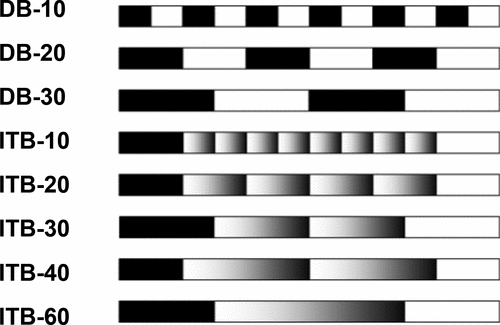当前位置:
X-MOL 学术
›
Macromolecules
›
论文详情
Our official English website, www.x-mol.net, welcomes your
feedback! (Note: you will need to create a separate account there.)
Multiblock Inverse-Tapered Copolymers: Glass Transition Temperatures and Dynamic Heterogeneity as a Function of Chain Architecture
Macromolecules ( IF 5.1 ) Pub Date : 2017-09-14 00:00:00 , DOI: 10.1021/acs.macromol.7b01476 Jarred Kelsey 1 , Nathan Pickering 1 , Andrew Clough 1 , Joe Zhou 1 , Jeffery L. White 1
Macromolecules ( IF 5.1 ) Pub Date : 2017-09-14 00:00:00 , DOI: 10.1021/acs.macromol.7b01476 Jarred Kelsey 1 , Nathan Pickering 1 , Andrew Clough 1 , Joe Zhou 1 , Jeffery L. White 1
Affiliation

|
Systematic variation of the size and number of inverse-tapered blocks in styrene–butadiene copolymers results in a wide range of accessible glass-transition temperatures (Tg), including Tg’s approaching that predicted by the Fox equation. Composition-weighted average Tg’s are expected for miscible blends or random copolymers, but such behavior has not previously been reported for block copolymers made from immiscible styrene and butadiene segments. In this work, 50:50 wt % multiblock copolymers with Mn = 120 000 kg/mol were synthesized using an inverse-tapered block design for all blocks except the end blocks. The total composition and molecular weight were held constant, but the type and number of blocks were systematically varied in order to compare contributions from the inverse-tapered chain interfaces to the overall glass transition behavior. Discrete copolymers of similar block number and length were investigated as controls to help separate contributions from the inverse-tapered design and the molecular weight of individual blocks. Some copolymers were intentionally designed such that individual block molecular weights were between the entanglement molecular weight (Me) of polystyrene (PS) and polybutadiene (PB). A range of intermediate glass transitions was observed, but the inverse-tapered copolymers that satisfied this latter condition were the only copolymers that exhibited a Tg near a composition-weighted average. Solid state NMR reveals dynamic heterogeneity among monomeric components through chain-level identification of relatively large amounts of rigid PB segments and mobile PS chain segments versus that observed in discrete block analogues where essentially all PB segments are mobile and all PS segments are rigid. NMR revealed subtle differences in the temperature-dependent segmental chain dynamics of different inverse-tapered blocks, which were not obvious from the calorimetric studies but which presumably contribute to the longer length scale Tg behavior.
中文翻译:

多嵌段反锥型共聚物:玻璃化转变温度和动态异质性随链结构的变化
苯乙烯-丁二烯共聚物中反锥度嵌段的大小和数量的系统变化导致可达到的玻璃化转变温度(T g)很大,包括T g接近Fox方程预测的温度。预期可混溶共混物或无规共聚物的成分加权平均T g为,但以前从未报道过由不溶混的苯乙烯和丁二烯链段制成的嵌段共聚物的这种行为。在这项工作中,M n为50:50 wt%的多嵌段共聚物对于每个嵌段,除末端嵌段外,使用反锥形嵌段设计合成了= 120000 kg / mol。总组成和分子量保持不变,但是嵌段的类型和数量被系统地改变,以便比较反锥形链界面对整体玻璃化转变行为的贡献。研究了嵌段数和长度相似的离散共聚物作为对照,以帮助从反锥形设计和单个嵌段的分子量中分离出贡献。有意设计了一些共聚物,使各个嵌段分子量在纠缠分子量(M e)的聚苯乙烯(PS)和聚丁二烯(PB)。观察到一定范围的中间玻璃化转变,但是满足后一种条件的反锥形共聚物是唯一表现出接近组成加权平均值的T g的共聚物。固态NMR通过链级鉴定相对大量的刚性PB链段和可移动PS链段,揭示了单体组分之间的动态异质性,而在离散的嵌段类似物中,基本上所有的PB链段都是可移动的,而所有PS链段都是刚性的。NMR揭示了不同的反锥形嵌段的温度依赖性链段动力学的细微差异,这从量热研究中并不明显,但可能有助于更长的长度尺度T g行为。
更新日期:2017-09-14
中文翻译:

多嵌段反锥型共聚物:玻璃化转变温度和动态异质性随链结构的变化
苯乙烯-丁二烯共聚物中反锥度嵌段的大小和数量的系统变化导致可达到的玻璃化转变温度(T g)很大,包括T g接近Fox方程预测的温度。预期可混溶共混物或无规共聚物的成分加权平均T g为,但以前从未报道过由不溶混的苯乙烯和丁二烯链段制成的嵌段共聚物的这种行为。在这项工作中,M n为50:50 wt%的多嵌段共聚物对于每个嵌段,除末端嵌段外,使用反锥形嵌段设计合成了= 120000 kg / mol。总组成和分子量保持不变,但是嵌段的类型和数量被系统地改变,以便比较反锥形链界面对整体玻璃化转变行为的贡献。研究了嵌段数和长度相似的离散共聚物作为对照,以帮助从反锥形设计和单个嵌段的分子量中分离出贡献。有意设计了一些共聚物,使各个嵌段分子量在纠缠分子量(M e)的聚苯乙烯(PS)和聚丁二烯(PB)。观察到一定范围的中间玻璃化转变,但是满足后一种条件的反锥形共聚物是唯一表现出接近组成加权平均值的T g的共聚物。固态NMR通过链级鉴定相对大量的刚性PB链段和可移动PS链段,揭示了单体组分之间的动态异质性,而在离散的嵌段类似物中,基本上所有的PB链段都是可移动的,而所有PS链段都是刚性的。NMR揭示了不同的反锥形嵌段的温度依赖性链段动力学的细微差异,这从量热研究中并不明显,但可能有助于更长的长度尺度T g行为。











































 京公网安备 11010802027423号
京公网安备 11010802027423号